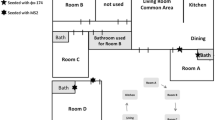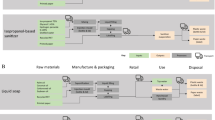Abstract
This study determined whether a hand sanitizing wipe can reduce virus transmission in households, and could reduce the probability of infection by rhinovirus and rotavirus. Bacteriophage MS-2 (a marker virus) was used to assess viral transmission in five households having at least two children of ages 2–18. Hands of one female adult were inoculated with ~108 PFU MS-2 bacteriophages in each home, and after 8 h, hands of all family members and select fomites were sampled to determine baseline contamination without intervention. This sequence was repeated with the intervention, where all family members were instructed to use a quaternary ammonium compound-based sanitizing wipe at least once per day. A significant reduction of virus after the intervention occurred on inoculated hands (95.3 %; p = 0.0039), all fomites combined (74.5 %; p < 0.005), and non-inoculated hands and fomites combined (73.5 %; p < 0.005). However, viral reduction on non-inoculated hands was not significant, likely due to small sample size. Using rhinovirus and rotavirus as models it was estimated that infection risk was reduced by ~30 to 89 % with the use of sanitizing wipes once per day depending on the starting concentration of these viruses on hands of susceptible individuals. Therefore, using a hand sanitizing wipe can significantly reduce viral transmission and risk of illness in homes. Previous studies have shown other hand hygiene interventions, such as alcohol-based hand sanitizers, are even more effective for reducing risk of illness in homes; however the sanitizing wipe used in this study is appropriate to use for microbial reduction.
Similar content being viewed by others
References
Bloomfield, S. F., Aiello, A. E., Cookson, B., O’Boyle, & Larson, E. L. (2007). The effectiveness of hand hygiene procedures in reducing the risks of infections in home and community settings including handwashing and alcohol-based hand sanitizers. American Journal of Infection Control, 35, S27–S64.
Boyce, J. M., & Pittet, D. (2002). Healthcare Infection Control Practices Advisory Committee. Society for Healthcare Epidemiology of America. Association for Professionals in Infection Control. Infectious Diseases Society of America. Hand Hygiene Task Force. Guideline for hand hygiene in health-care settings: Recommendations of the healthcare infection control practices advisory committee and the HICPAC/SHEA/APIC/IDSA hand hygiene task force. Infect Control Hosp Epidemiol, 23(12 Suppl), S3–S40.
Dyer, D. L., Shinder, F. S., & Shinder, A. L. (2000). Alcohol-free hand sanitizer reduces elementary school illness absenteeism. Family Medicine, 37, 633–638.
Gerba, C. P. (2015). Quaternary ammonium biocides: Efficacy in application. Applied and Environmental Microbiology, 81, 464–469.
Kabacoff, R. I. (2011). R in action: Data analysis and graphics with R. New York: Manning Publications CO.
Liu, P., Escudero, B., Jaykus, L. A., Montes, J., Goulter, R. M., et al. (2013). Laboratory evidence of Norwalk virus contamination on the hands of infected individuals. Applied and Environmental Microbiology, 2013(79), 7875–7881.
Nicas, M., & Best, D. (2008). A study quantifying the hand-to-face contact rate and its potential application to predicting respiratory tract infection. Journal of Occupational and Environmental Hygiene, 5, 347–352.
Ott, R. L., & Longnecker, M. (2001). An introduction to statistical methods and data analysis (5th ed.). California: Duxbury Press.
Reed, S. E. (1975). An investigation of the possible transmission of rhinovirus colds through direct contact. Journal of Hygiene Cambridge, 75, 249–258.
Rusin, P., Maxwell, S., & Gerba, C. (2002). Comparative surface-to-hand and fingertip-to-mouth transfer efficiency of gram-positive bacteria, gram-negative bacteria, and phage. Journal of Applied Microbiology, 93, 585–592.
Tamimi, A. H., Carlino, S., Edmonds, S., & Gerba, C. P. (2014). Impact of a hand sanitizer intervention on the spread of viruses in homes. Food and Environmental Virology, 6, 140–144.
Tamimi, A. H., Maxwell, S., Edmonds, S. L., & Gerba, C. P. (2015). Impact of the use of an alcohol-based hand sanitizer in the home on reduction in probability of infection by respiratory and enteric viruses. Epidemiology and Infection. doi:10.1017/S0950268815000035.
White, C. G., Shinder, F. S., Shinder, D. O., & Dyer, D. L. (2001). Reduction of illness absenteeism in elementary schools using alcohol-free instant hand sanitizer. The Journal of School Nursing, 17, 258–265.
WHO. (2009). WHO guidelines on hand hygiene in health care. Geneva: World Health Organization.
Zumel, N., & Mount, J. (2013). Practical data science with R (1st ed.). New York: Manning Publications.
Author information
Authors and Affiliations
Corresponding author
Rights and permissions
About this article
Cite this article
Tamimi, A.H., Edmonds-Wilson, S.L. & Gerba, C.P. Use of a Hand Sanitizing Wipe for Reducing Risk of Viral Illness in the Home. Food Environ Virol 7, 354–358 (2015). https://doi.org/10.1007/s12560-015-9204-6
Received:
Accepted:
Published:
Issue Date:
DOI: https://doi.org/10.1007/s12560-015-9204-6




